QuestionI recently took in a stray female cat, her name is Ash and she is about 6 months old. I took her to the vet at the beginning of November. She had a FeLuk/FIV test done which had a negative result, and was vaccinated with FVRCP+FeLuk, and dewormed. She is supposed to go back at the beginning of December to get a second shot......
On Monday 11/28, I took her, and two of my other cats (also 6-7 months old), to another veterinarian to be spayed and neutered...... Monday evening when I went to pick up the male they also gave me Ash and told me that they couldn't do the procedure because she had a temperature of 104.2 (which they didn't take until after they had already put her under anesthesia and had already shaved her belly before they realized she felt warm). They proceded to tell me that she probably had FIP-wet form, because of the temperature, she seems under-developed/underweight for her age, and she had a "pot belly", and that she probably only has about 6 months to live......
The next day after the anestesia wore off she was back to her usual affectionate self and didn't have a fever, temp was 102.2.... She is eating fine, has normal stools and urine, and not vomiting. She does not have any discharge from her eyes, nose or ears, and is active and playful. She seems like a happy healthy cat to me.
My questions are these:
1. I recently found out that I am pregnant; is there any risk to me or my baby from a cat that has FIP? If so what is the risk?....
2. I have 3 other cats. One is 7 1/2 years old, and the other 2 are 6-7 months old. The two 6-7 month olds interact frequently with each other, but not much with Ash. The 7 1/2 year old doesn't interact with any of the other 3 cats. Are they at risk for being infected with FIP? I'd read that the incidence of Environmental exposure to FIP is really low if the cats don't really interact with each other; Is this true?....
3. Is there any way that it could be something other than FIP, and if so what are the other possiblilites?....
4. Can an adverse reaction to anestesia cause a cats temperture to rise for a time?....
Thank you for any information you can give me on this, I really appreciate you taking the time to answer my questions.
Answer1. I recently found out that I am pregnant; is there any risk to me or my baby from a cat that has FIP? If so what is the risk?....
NO, this is a cat to cat issue from a corona virus. However, being pregnant you should not be scooping litter boxes due to Toxoplasmosis exposure from any cat.
2. I have 3 other cats. One is 7 1/2 years old, and the other 2 are 6-7 months old. The two 6-7 month olds interact frequently with each other, but not much with Ash. The 7 1/2 year old doesn't interact with any of the other 3 cats. Are they at risk for being infected with FIP? I'd read that the incidence of Environmental exposure to FIP is really low if the cats don't really interact with each other; Is this true?....
Corona virus is EVERYWHERE in the environment and many cats are exposed to it. They are not sure exactly what happens with the case of FIP but it is believed to be the body mutating the virus which leads to formation of the fluid and immune complexes. I would separate the other cat to be on the safe side.
3. Is there any way that it could be something other than FIP, and if so what are the other possiblilites?....
If the fluid in her belly is yellow and sticky, then it is FIP and she is terminal. If the fluid is clear, then it could just be an overwhelming amount of intestinal parasites. I would take a stool sample to the vet to be checked as intestinal parasites can be transmitted to your other cats as well as people. Even if the stool sample is negative, I would recommend giving her a course of deworming as well to be on the safe side. Or she could be pregnant.
4. Can an adverse reaction to anestesia cause a cats temperture to rise for a time?.... Yes this could be a possibility and they should have taken her temperature BEFORE anesthesia. Often with FIP cats will spike fevers that are not responsive to antibiotics.
HERE IS A FULL ARTICLE ON FIP for more info....
Feline Infectious Peritonitis, FIP
AffectedAnimals:
Both domestic and exotic cats are susceptible. Purebred kittens are suspected to be genetically less resistant to FIP infection.
Overview:
Cats that are infected with feline coronavirus, a contagious virus transmitted through feces and saliva, run the risk of developing feline infectious peritonitis, a rare and deadly form of this disease. In most cases, the coronavirus itself is not serious, but FIP is usually fatal. FIP causes the cat's immune system to attack its own cells, damaging blood vessels throughout the body. Without adequate blood flow, many of the body's organs are severely damaged and fail. Cats that show signs of FIP generally die from it quickly.
There are two forms of FIP, both of them equally life threatening. The effusive, or "wet," form occurs when fluid is produced in the body's cavities, often resulting in a swollen abdomen, fever, weight loss, and breathing difficulties. The second form, which is non-effusive, or "dry," can lead to neurological disorders such as seizures and brain damage.
FIP is a frustrating disease to veterinarians. It is not yet understood why certain cats with the coronavirus develop FIP while others do not. There is no cure or completely effective vaccine for this fatal illness, nor is there a diagnostic procedure, short of an autopsy, that will conclusively determine the presence of FIP; thus, diagnosis is based on suspicion and clinical signs. The preventive measures available, however, are fairly effective in deterring the spread of FIP.
Clinical Signs:
Clinical signs of the effusive form of FIP can vary, but typically include ascites, depression, anorexia, weight loss, fever, dyspnea, and tachypnea. Clinical signs of non-effusive FIP may include pyrexia, weight loss, depression, anorexia, ocular lesions, icterus, and neurological signs such as ataxia and seizures.
Symptoms:
Clinical signs of the "wet" form of FIP can include a gradual swelling of the abdomen due to fluid building up in the cavity, depression, decreased or absent appetite, weight loss, fever, difficulty breathing, and a rapid respiratory rate. Clinical signs of the "dry" form of the disease may include fever, weight loss, depression, decreased or absent appetite, eye problems, a yellow color to the eyes or skin, and neurological signs such as difficulty walking and seizures.
Description:
Feline infectious peritonitis is caused by the feline coronavirus, which is shed in the saliva and feces. Generally, cats and kittens that become infected by the coronavirus have fairly mild symptoms such as diarrhea and vomiting that resolve without significant medical intervention. However, FIP, a rare form of coronavirus infection, is a deadly disease with no cure.
The FIP virus causes multiple changes in the body's immune system, leading to a destruction of the blood vessels that results in an inadequate supply of oxygen to the body's cells. The disease manifests itself in two ways: effusive FIP or non-effusive FIP. The effusive or wet form is characterized by the production of large amounts of fluid throughout the cat's body occurring because the affected cat's immune system releases signals that cause the blood vessels to become more permeable. As a result, fluid and white blood cells leak out of the vessels into the body cavities, causing severe damage throughout the body. When the blood vessels can no longer deliver oxygen-rich blood to the organs, the cells in those organs die, resulting in multi-organ failure and death.
Although there is no fluid production with the dry form of the disease, multi-organ failure can result from this manifestation of the illness as well. In addition, non-effusive FIP can attack the brain, causing neurological disorders such as seizures.
Diagnosis:
The veterinarian must look for clinical signs of the disease by taking a thorough history, performing a complete physical examination of the cat, and taking blood tests that detect abnormalities in body organs, such as the kidney or liver.
For cats that have symptoms of effusive FIP, an important diagnostic procedure requires taking a sample of the fluid that is building up within the cat's abdomen and submitting this for analysis of the cell types and protein content present within the fluid. For cats that show signs of the dry form of the disease, an organ biopsy of the kidneys and lymph nodes can be taken and sent to a pathologist to look for the microscopic changes that occur in cats with FIP. This procedure is not always recommended, however, as it creates stress that can worsen a sick cat's condition.
At this time, there are no specific diagnostic tests short of autopsy that can determine definitively whether a cat has FIP. The blood tests that are available simply determine if the cat has been exposed to the coronavirus. Exposure to the coronavirus, however, does not mean necessarily that the animal has FIP; typically, the coronavirus leads to other minor disorders, such as intestinal problems like diarrhea and vomiting.
Serologic testing for exposure to feline coronavirus may be conducted if the clinical signs of FIP are suggestive of the disease and confirmation of exposure is needed. An owner may need such a confirmation to ensure that a pet is not transmitting the disease to other animals. Breeding facilities also may request such testing to determine whether there is a danger of spreading the coronavirus to other cats.
Prognosis:
Cats that develop clinical signs of FIP have a grave prognosis: almost 100 percent of them will die. Euthanasia, or humanely putting the cat to sleep, is generally recommended.
Transmission or Cause:
FIP is caused by feline coronavirus. Cats acquire the coronavirus when they come into close contact with the feces or saliva of infected cats. Kittens may be more susceptible to developing FIP because their immune systems are less developed, and there may be a genetic predisposition for purebred kittens to get the disease. The virus can be transmitted during grooming, through the ingestion of infected feces, from sneezing, and from close contact with items such as litter boxes and food bowls used by cats with the disease. The virus can survive in the environment in dry conditions for long periods of time. Less commonly, a mother cat can pass on the disease to her unborn kittens.
Treatment:
The treatment for cats with significant clinical signs of FIP is usually unrewarding. Because there is no cure for the virus, treatment must take the form of supportive care. Drugs that suppress the immune system and help decrease the inflammation have been used with limited success. All cats that have FIP should be made to rest in a stress-free environment.
Prevention:
Litter boxes should be kept clean. The use of vaccines has been controversial, but a new vaccine called Primucell, given intranasally, offers local protection in the nose and back of the throat, which are common sites of entry for the virus. Studies have shown that the vaccine is safe, and although it is not completely effective, it does offer some protection against FIP. It is advised to test a cat for coronavirus prior to administering this vaccination, as the vaccine is unlikely to be effective if the cat is incubating the disease. Also, cats will test positive for exposure to the virus following vaccination.
Because of the increased risk of FIP in areas highly populated with cats, breeders and owners of catteries especially should concern themselves with prevention. The way newborn kittens from infected mothers are handled from birth determines whether they will become infected with the coronavirus. One to two weeks before delivery, the birthing area should be kept free of cats and should be disinfected with a bleach solution made by adding one part bleach to 31 parts water. If the mother cat tests positive for the coronavirus, the newborns should be removed from her at five to six weeks of age to prevent infection; before this time period, they will be protected from the disease by the mother's antibodies.

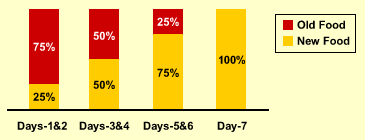 Puppy wont eat
QuestionHello, i have a 8 week old golden retriever and
Puppy wont eat
QuestionHello, i have a 8 week old golden retriever and
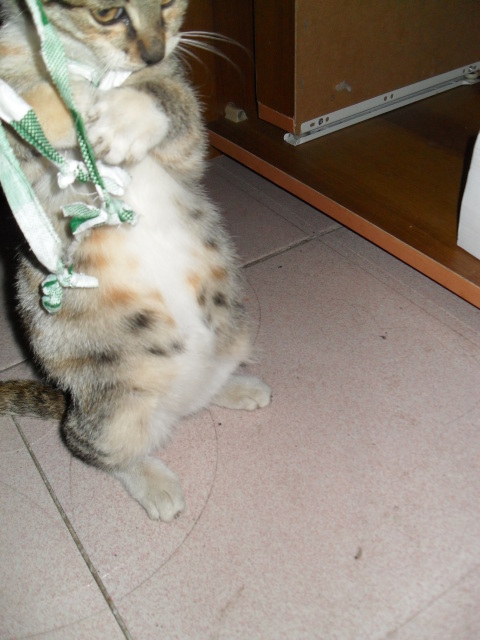 Feral cat with bloated stomach
Question
Cats stomach
Hello,
Id like some help with a
Feral cat with bloated stomach
Question
Cats stomach
Hello,
Id like some help with a
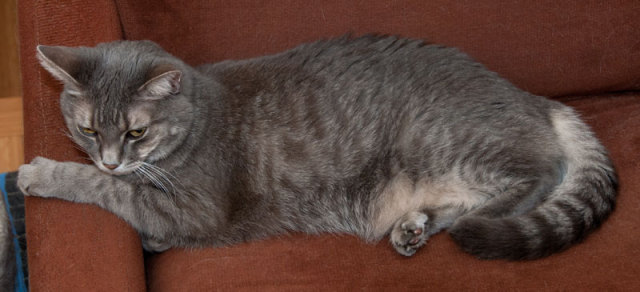 Radioiodine treatment of hyperthyroidism in our cat
Question
Molly
Dear Jana,
I wrote you near the end of
Radioiodine treatment of hyperthyroidism in our cat
Question
Molly
Dear Jana,
I wrote you near the end of
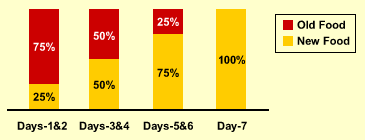 Kitten depression after fostering
QuestionQUESTION: I have been fostering a kitten for 3
Kitten depression after fostering
QuestionQUESTION: I have been fostering a kitten for 3
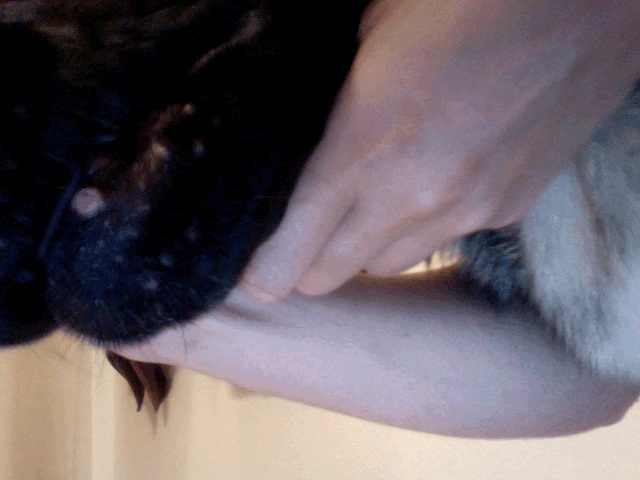 German Shepard has red sore on lip
Question
sore on charlies lip
The other day I no
German Shepard has red sore on lip
Question
sore on charlies lip
The other day I no